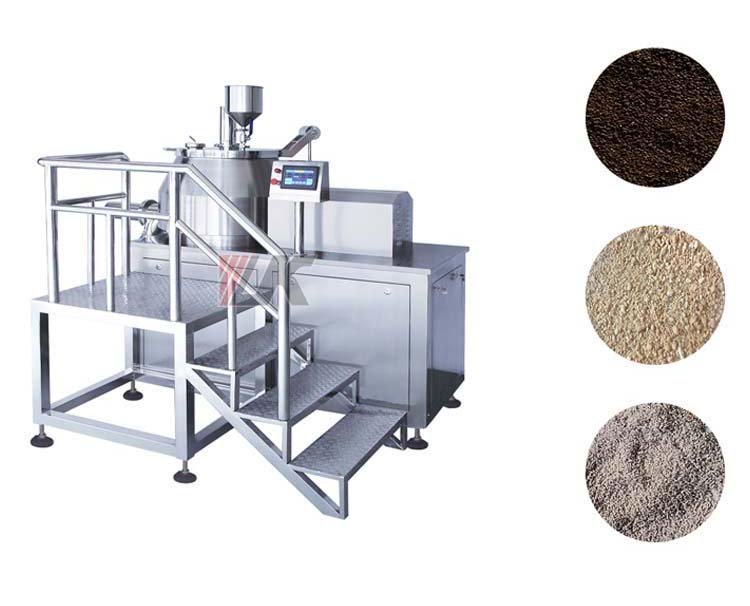Writer: admin Time:2020-03-25 17:33 Browse:℃
I. What is granulation?
1. Definition:
Granulation is a technology to process powders, melt and aqueous solution into granules of certain shape and size.
2. Goal
1) To better fluidity for convenient packing and pressing;
2) To avoid isolation due to different size and density of materials;
3) To prevent dust from flying and sticking to device wall;
4) To adjust bulk density and better solution performance;
5) To improve pressure uniformity during tablet production;
6) For convenience taking, portability and higher goods value.
3. Methods
Wet granulation, dry granulation, fluidized-bed granulation( fluid bed drying granulation), spraying granulation. Among them, wet granulation is applied the most widely.
4. Application
It is the most widely applied for solid preparation, such as granules and tablets.
II. What are the most common granulation method
1. Wet granulation
1) What is wet granulation?

At first, adhesive or moisturizer is added into medicine powders to prepare mixture. The mixture is then sieved and shaped into wet granules. These granules are dried and sized. This process if defined as wet granulation. Granules made by this way are of smooth surface, beautiful appearance, strong abrasion resistance and good compressibility. It is most widely used in pharmacy.
2) The working principle of wet granulation
At first, liquid in adhesive will wet medicine powder surfaces to generate adhesion between powders. Under liquid force and external mechanical force, granules of certain shape and size are formed. After drying, they become solid and steady.
3) Wet granulation consists of steps of mixing, wet granulation, wet granule drying and sizing.
A. Mixing:
Mixing fine material powders prepared according to formula and adding some proper moisturizer and adhesive to produce mixture.
a. Key points to pay attention to:
i. Adhesive type and dosage are determined by material features;
ii. Adhesive concentration and mixing time should be flexible depending on its type;
iii. Mixture quality. Since materials are different, it is difficult to make standard. Generally, we can lump it and scatter the lump easily.
iv. Mixture is also closely related to mixing time. The longer materials are mixed, the adhesion is larger and the harder particles are.
B. Wet granulation:
After screening, mixture becomes particles. Long particles indicate that mixture is too wet, i.e., too much moisturizer is added; on the other hand, if mixture after screening is powder, it shows that mixture is too dry and should be adjusted properly.
a. Common equipment: oscillating particle machine, high speed mixing and granulating machine.
b. Screen types: four types of nylon, galvanized wire, stainless steel and plate.
C. Wet granule drying:
Wet granules should be dried right after screening to avoid lumping or out-of-shape. SS plate can be applied to store wet granules uniformly to solve the above problem. Now if we connect the wet granulation with the fluid bed dryer, all the granules are transferred into the fluid bed dryer for drying immediately, so this problem can be avoided. This full automatic closed production line is the tendency in the future and applied more and more.
a. Drying temperature: It depends on material natures. Generally, the temperature should be 50-60°C. Some medicines can still keep stable in high humidity and temperature. In this case, drying temperature can be properly raised to 80-100°C.
b. Drying degree: It can be controlled through measurement to water content. Water content cannot exceed 2% for granules and is around 3% for tablets, depending on specific type.
c. Drying equipment: box drying, fluid-bed drying, microwave drying and infrared drying.
D. Sizing:
After drying, granule lump can be scattered through sizing to meet requirements on particle size or tablet pressing.
a. Granule: The screen mesh should be smaller than that of the screen which is used to produce wet granules and less than 10 mesh, i.e., #1 screen. Some granules that cannot pass through sieves can be scattered appropriately. Then according to size requirement and the minimum size, granules are screened with screen of 60 or 80 meshes, i.e., #5 screen. Granules of 10-80 meshes are proper.
b. Tablet: Granules for tablets can be screened with the screen whose mesh is lager than that of the screen sieving wet granules.
E. Blank granulation:
Some medicines are sensitive to humidity and heat and are of small dosage. Therefore, some auxiliary materials can be wet granulated first wit some medicines insensitive to humidity and heat. After drying and sizing, the former medicines can then be mixed with latter granules. Such a way is called blank granulation.
Tel: +86 731 84325468
Phone: +86 13787413551
Email: ava@lkpharmamachinery.com
Whatsapp: +86 13787413551(Ms. Ava)
Add: Ruian city, Zhejiang province